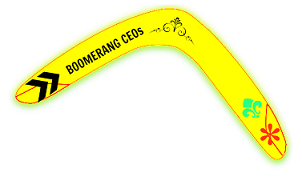I’ll be back
You have heard about product recalls. Every company (from toy manufacturers like Mattel to automobile companies like Toyota to food product manufacturers) recalls its product or takes corrective action for its services, sometime or the other during its lifetime. Some researchers suggest that each year more than 2,500 product recalls occur in the U.S. alone. The idea is to protect the reputation of the company (which is committed to safe practices) and avoid fallout with the customer.
The trend nowadays has been towards recalling the founders or CEOs who have performed brilliantly in the past and left the company. Of course the anticipation is that the founder or returning CEO will be able to affect a turnaround of sorts at the troubled company. The idea here again (as with a product recall) is to protect the company’s failing reputation and avoid losing customers.

A Back to the Future approach
A common factor among companies recalling their CEOs is the preference for insiders who know the working of the company and more importantly, the industry in which they operate. They have had a successful track record at running the company and know how to respond to a challenging situation i.e. they already have CEO-level experience.
Comeback CEOs
CEOs or founders who return to the company are commonly being referred to as ‘Boomerang CEOs’. Let us take a look at some of them –
Return of Steve Luczo at Seagate
In 2009, Steve Luczo returned to Seagate Technology Inc., a data storage company, as CEO replacing Bill Watkins. Earlier, he was CEO from 1998 to 2004. In 2012, Fortune Magazine named him one of the Top 50 Businesspersons of the Year for turning around the company. Seagate was struggling with declining market share, rising costs, and massive debt. The company’s market value was less than $1.5 billion at the time of hiring Luczo. In 2007, an attempt to organize the company into business units had failed. When he came back, Luczo corrected this by overhauling the entire management team and reorganizing the company back to a functional structure. Shares rose from mere USD 5 in 2009 to USD 37 in three to four years later.
Lafley’s return to P&G
In May 2013, P&G, the world’s largest consumer product maker replaced its CEO Robert McDonald with Alan George Lafley. Lafley re-joined P&G as President and Chairman. Earlier, Lafley had been CEO with the company from 2000 to 2009. Lafley’s job is to improve sales of products, bring in new products and cut costs.
Mike Ullman’s return at J.C. Penney
Myron Ullman, ran J.C. Penney Co., the retailer from 2004 to 2011. In February 2012, he was replaced by Apple’s Ron Johnson. Johnson’s strategy “everyday low pricing” did not work as sales dipped $4.3 billion, with a loss of almost $1 billion. Johnson had dropped several brands, sales initiatives and coupons. By April 2013, Ullman was back as CEO. Ullman immediately promised bringing back three or four of private label brands dropped earlier by his predecessor.
Narayan Murthy’s return to Infosys
In May 2013, Infosys, an IT leader from India recalled its founder Narayan Murthy as Chairman. Infosys was clearly struggling in changing market conditions as competitor Cognizant displaced it from the second spot in the IT market in India.
Founders Dell, Schultz and Page return
Other famous leaders and founders who returned to their companies include Michael Dell to Dell Inc. in 2007, Howard Schultz to Starbucks in 2008 and Larry Page to Google in 2011. Howard Schultz was CEO from 1987 to 2000. Starbucks shares rose from USD 20 when Schultz returned in 2008 to around USD 58 in 2013. On his return as CEO, Larry Page immediately carried out a major reorganization of his management team in order to eliminate bureaucracy and lobbying while stepping up innovation.
Comeback King, Steve Jobs at Apple
But, the entire comeback CEOs would look to emulate charismatic leader Steve Jobs, founder of Apple. He was ousted from the company in 1985 in a power struggle. He became CEO again in 1997 and turned Apple into an iconic global brand.
